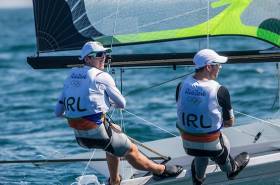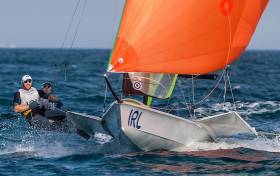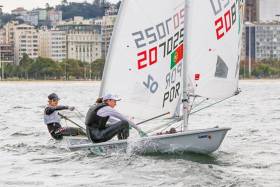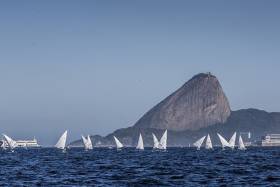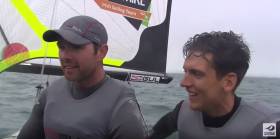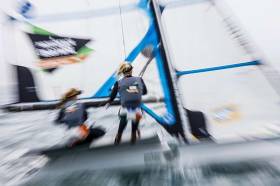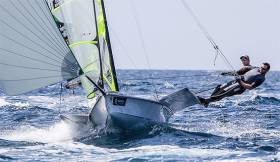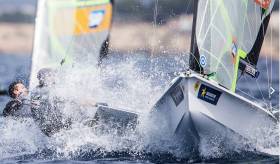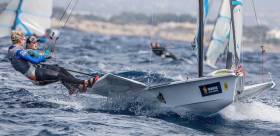Displaying items by tag: Ryan Seaton and Matt McGovern
Ryan Seaton & Matt McGovern Compete in 49er Medal Race To Seal Best Olympic Performance
Northern Ireland's Ryan Seaton and Matt McGovern gave themselves a great medal race boost by winning the final race of their qualification series in the 49er class on Tuesday. It was their second race win of the 12–race series. The Ballyholme Yacht Club pair are eighth overall on 103 points, some 33–points off the bronze medal position for today's race. Double points are at stake in today's medal race at 5pm (Irish time).
The best the Northern Irish pair can do is fifth overall as there are 33 points between themselves and third with only 20 points available. There are 23 points between fourth and eighth, but only 11 between fifth and eighth. The best possible result is to finish six places ahead of DEN, four ahead of FRA and three ahead of ARG.
In a week of high's for Irish sailing, their inclusion in today's climax is another major success for Irish Olympic sailing because – quite apart from Annalise's Olympic Silver medal performance and her fourth at London 2012 – if they can hold on to eighth it will be Ireland's only top eight finish overall since 1980. Seaton and McGovern finished 14th overall at their first Olympics in London four years ago having been in medal contention at the half way stage in Weymouth.
Overall, this means Rio represents Ireland's best ever Sailing Olympics by a long chalk.
Today, in the 49er class, Peter Burling and Blair Tuke (NZL) have already won the gold medal, and did it with two races to spare after dominating the 20-boat fleet at Rio 2016 over the past week. The New Zealanders have gone undefeated in major competition in the 49er fleet since taking the silver medal at London 2012. They have won all four of the last World Championships and were expected to deliver gold for New Zealand this week. Even Burling and Tuke might be surprised at the ease with which they've managed their extraordinary feat, however.
Behind them the battle rages on for the other medals, with Erik Heil and Thomas Ploessel (GER) holding second place in front of the 2012 Olympic Champions Nathan Outteridge and Iain Jensen (AUS).
Seaton & McGovern Seventh, Brewster & Tidey 12th in Rio Skiffs
Ireland's Men's 49er Skiff Ryan Seaton and Matt McGovern from Ballyholme Yacht Club in Northern Ireland are seventh overall after nine sailed races in Rio. Dun Laoghaire's Andrea Brewster and Saskia Tidey are 12th after nine races in their 20–boat 49erfx fleet. It was the most frustrating day so far of the Olympic sailing competition with the wind refusing to play fair on Guanabara Bay.
49er Skiff
Perhaps inspired by French gold and bronze in the Windsurfing the previous day, Julien d'Ortoli and Noe Delpech fired their way up the rankings into fourth place after mastering the Copacabana course with two firsts and a third place. This puts the French just two points behind the third-placed Australians, reigning Olympic Champions Nathan Outteridge and Iain Jensen.
Meanwhile it's business as usual for the ever dominant Peter Burling and Blair Tuke (NZL) whose scores of 2,3,1 have opened up an 18-point lead over Erik Heil and Thomas Ploessel (GER). Even if the gold is beginning to get away from the Germans, they do at least have a healthy 15-point lead over the Aussies, with just three qualifying races remaining before the Medal Race.
Burling said, "We're pleased with three low scores, the boat was going really fast. We had some beautiful conditions for racing but got hit by a massive squall on the way in. It was maybe 45 or 50 knots.” Tuke added, "A south-west front came in and it went from 11 knots to more than 40 knots in the space of ten minutes.” Even the four-time World Champions capsized in the storm-force conditions. "We struggled to stay upright just with the mast up. Some massive waves out there, just happy to be back on shore,” said Burling, shivering and itching to get back to checking over the boat for any damage.
The Germans seemed to enjoy the mad ride in through the storm a little more than the Kiwis. "We ragged it quite fast on the way in,” said Heil. "But what lucky timing. Just after the last guy came across the finish line, the breeze came in 130 degrees from the other side, and with massive force. Even with just the mast up and no sails, we still needed to get on the trapeze to stop the boat tipping over. We have some boat work to do, we have damaged the sails, we have to check the mast.”
Noe Delpech was barely thinking about what a good day he'd had after getting ashore - just happy to be in one piece. "We had three good starts and are very happy with our speed and strategy today. But then there was the wind that arrived straight afterwards. We capsized many times. The mainsail went flying through the air and it fell in the water but our coach managed to save it before we lost it. We had a bad last hour on the water. The sails are not in great condition but I think we are OK mostly.”
Delpech was pleased to have closed in on the podium, but like all Olympic sailors never likes to get ahead of himself. "We are two points behind the bronze medal position, so yes, for sure we can start thinking about the options to get a medal, but we have still three important races to do tomorrow. We just go race by race.”
The Skiffs will have to work quickly with another three races scheduled for tomorrow which looks to be a busy day. The Laser, Laser Radial, Finn and Nacra 17 will all have their Medal Race due to the postponements from today.
Women's Skiff – 49erFX
Tamara Echegoyen and Berta Betanzos (ESP) fired two bullets from today's three races on the Niterói course moving the reigning World Champions to the top of the scoreboard. Behind them are two former World Champion crews, Alex Maloney and Molly Meech (NZL) who are four points behind the Spanish in second, and Martine Grael and Kahena Kunze (BRA) just one point behind the Kiwis in third overall.
Although previous overnight leaders Jena Hansen and Katja Salskov-Iversen (DEN) scored a second in the last race of the day their earlier scores of 9,16 have hurt the Danish team who are now fourth overall. However, the Danes are only nine points off the lead and there are still three more qualifying races scheduled for Tuesday before Thursday's Medal Race.
Echegoyen, the London 2012 Olympic Champion in match racing, commented, "We are very happy, we have sailed very well today. It was very important to be very open minded, to be able to adapt ourselves to what was happening. We were well prepared for today's three races, both in terms of understanding the conditions with our meteorologist and also regarding the tactics.
"In the two first races it was clear where to go, but the third one was really crazy and we just sailed with the wind shifts. It has been a good day, but also quite difficult, we have had to work a lot. These results give us the confidence to keep on going in this way. Now we are leading but we are all very close on points. Still three races and the Medal Race ahead, so we have to go step by step and keep on going.”
Ireland's Sailing Olympians Deserve Serenity In Their Cocoon
Ireland’s six sailing Olympians have reached their selections for the 2016 Games at different times. Some have been secure with their places for many months, while others have been confirmed more recently, with the final place being filled on May 18th. Now, if all goes according to plan, for the next six days they’ll be at some remove from the petty hassles of everyday life, safe in a cocoon of mental and physical security as the clock ticks steadily on towards their appointment with destiny. The official opening of the 2016 Games is in Rio de Janeiro next Friday (August 5th). Then for the ISA squad, it’s into practice races and the start of the Sailing Olympiad on Monday August 8th. W M Nixon takes an overview.
The Olympic Games are very important for Irish sailing. Some would say disproportionately so, while a few contrarians might even argue that, as a vehicle and equipment sport as much as a physical pursuit, sailing is questionably Olympian in the first place, and certainly not mainstream.
Perhaps. But for a specialist sport like sailing, the Olympics provide a unique four year opportunity to be in the national and international limelight. Over the years, we’ve learned that an Olympic Medal – or even the prospect of one - is a matter for general interest and celebration regardless of how the sport in question is perceived by the general public at home.
Like it or not, the Olympics simplify it all. And the value of winning a medal, even the most modest one, is almost beyond quantification. But at the very least, if at the Olympics you put in an honourable performance, clearly give of your very best, do your uttermost as part of a warm human story, then your sport’s feelgood factor rises to provide new levels of interest and tangible support at official level.
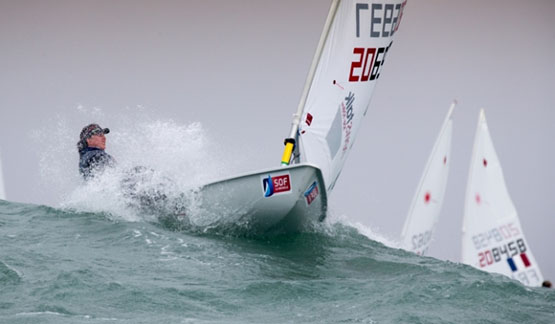 The Olympics may reduce sailing to its basics, but when a medal seems a possibility – as for Annalise Murphy in 2012 – suddenly our specialist sport comes centre stage at national level
The Olympics may reduce sailing to its basics, but when a medal seems a possibility – as for Annalise Murphy in 2012 – suddenly our specialist sport comes centre stage at national level
But how can Olympic sailing project itself as something of particular human interest? It’s simple. People want a people story, and while sailors will happily discuss the minutiae of boat design, sail shape and equipment structure for hours on end, Joe and Josephine Public think a boat is just a thing, and an odd, often wet, and uncomfortable thing at that. They want a human story with which they can identify, and if they don’t get that human story - and quickly – their interest will immediately move elsewhere, for there’s any amount of ready distraction in today’s world.
Time was when the Olympics were about catering for the needs of the athletes, but now the demands of an instant global audience dictate everything. And time also was when the sailing Olympics had at least as many keelboat classes as it had dinghies, and the venue was selected at locations sometimes hundreds of miles from the hosting city in order to provide “ideal” sailing conditions.
But in this age of cities, the demands of the glamour city dominate, and if the host city happens to be picturesquely beside the sea, then that’s where your sailing will be, regardless of the effect of a steep coastline and high buildings on the winds of the race area.
As for keelboats in the sailing Olympics, forget it. Ballast keels reduce the need for athletic capability. And forget individuality and a sense of ownership in boats. Today’s Olympic sailing ideal is exemplified by the Laser, with anonymous newly-manufactured utterly standard boats, sails and masts allocated only days before the event, thereby making the athleticism and ability of the sailors the paramount factor, rather than having any technological edge in boat and equipment.
This paring-back of our beloved sport means that the inevitably ageist structure of the modern Olympic sailing team is not at all representative of the true overall picture of modern world sailing, with its themes of a Sport for Life, and Love Your Boat. With our global spread of 143 different boat classes entitled to hold a world championship, sailing is something of a mystery for the rest of the world. Yet it’s only with the artificially-imposed simplicities of Olympic sailing that we get a chance to explain what it might be about.
Or more accurately, we get a chance to see how the general run of journalists respond to sailing. For it’s only with the very big things of popular interest like the Olympics and maybe the America’s Cup, and perhaps disaster stories like the Fastnet Race of 1979, that your solitary sailing journo gets to rub shoulders with other journalists. So when the ISA staged a Press & Radio Conference this week for the media to meet and question the 2016 Olympic Sailing squad, we went along not to ask questions ourselves, but rather to hear what sort of questions these inquiring representatives of the outside world would ask about sailing.
It’s ironic, but once upon a time it was thought that yachting reports should really appear in the social and gossip pages rather than in the sports pages. Yet today, thanks to its involvement in the Olympics with that nationally-electrifying almost-Medal of 2012 and the ever-increasing emphasis on human stories, sailing is now accepted in Ireland as a proper sport.
 Once upon a time, it was thought that sailing was best reported in the social and gossip pages...
Once upon a time, it was thought that sailing was best reported in the social and gossip pages...
But the reality beyond that is that all sports, sailing included, are now being reported with the emphasis on the human angle rather than on the athletic and technical issues, though of course good old-fashioned winning is still paramount. But as for how that win is achieved – well, open any sports section of a print newspaper (remember them?) and most of the photos will be of people, frequently in facial close-up and showing extreme reaction to some incident or achievement which is of itself so incidental that it is seldom illustrated.
Thus we’re getting to the stage that serious newspapers are veering away from carrying anything like old-fashioned social diaries. Today any event – whether it be a sports championship, company annual general meeting, or a major political announcement – is reported as though it belongs in the social diary, becoming just another happening in the daily progress through the world of the nation’s social life.
So although Tuesday’s press conference made token gestures of getting to grips with how our youngest Olympic sailor Finn Lynch seems to do all his main training in Croatia, and whether or not Annalise Murphy has been made ill by the fact that she has put in significant time during the past three years training in the polluted waters of Rio de Janeiro (she hasn’t), really what the press corps wanted was human stories based on past events to which their readers could relate, and happily for Irish Olympic sailing, our team could come up with the goods.
Thus next morning’s papers came up with a story in the general news pages about how Saskia Tidey continues to draw inspiration from her 81-year-old kidnap-surviving dad Don, while another paper had the sports pages telling of how Annalise Murphy came within a whisker of winning the Bronze in 2012, but then came to terms with it, put it behind her, and went into the dedicated count-down towards Rio 2016.
 Andrea Brewster and Saskia Tidey, 49erFX Olympic crewAs for the 49er guys from the north, Ryan Seaton & Matt McGovern, they provided oodles of copy about just how they’ve managed to stay together for so long to such an extent that you could see a spectral “The Odd Couple” sign hovering over them during their part of the show.
Andrea Brewster and Saskia Tidey, 49erFX Olympic crewAs for the 49er guys from the north, Ryan Seaton & Matt McGovern, they provided oodles of copy about just how they’ve managed to stay together for so long to such an extent that you could see a spectral “The Odd Couple” sign hovering over them during their part of the show.
And then to give everyone a warm community feeling, we’d the real page-turner of how Finn Lynch of Bennekerry in County Carlow comes to be the youngest sailor in Ireland’s Olympic squad. As the details of that were teased out, we may have learned more about the GAA in Bennekerry and the little sailing club in Blessington than we did about the Laser in Rio. But if the purpose of Tuesday’s gathering was to give Irish Olympic sailing a friendly and responsive human face, then Finn Lynch and his team mates have won gold in the social stakes already.
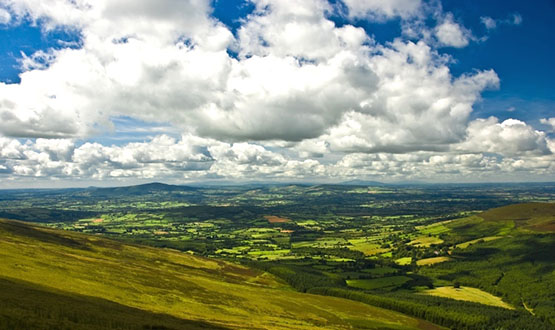 Profoundly rural – Finn Lynch’s home county of Carlow
Profoundly rural – Finn Lynch’s home county of Carlow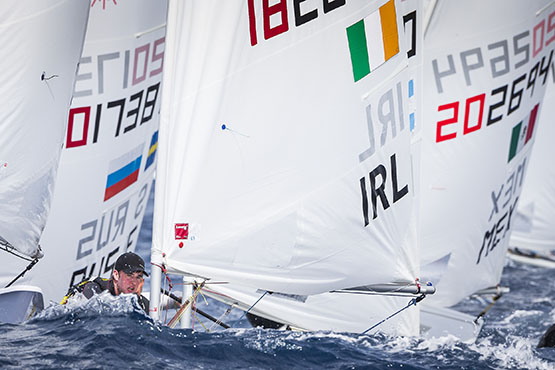 The Young Man and The Sea – Finn Lynch takes the Olympic Laser place in Mexico on May 18th
The Young Man and The Sea – Finn Lynch takes the Olympic Laser place in Mexico on May 18th
Their boats? At the conference, boats were very quickly shunted aside in the pursuit of human stories. Boats are trouble enough to comprehend, sailing boats are double trouble. The problem with sailing boats is sails. Mysterious sails harnessing the invisible wind can make the straightforward fact of Olympic participation into something very weird.
With rowing, by contrast, you may have boats, yet it’s so obviously sheer athletic prowess which brings rowing success. But sailing? For sure, athletic ability, training and coaching are more important than ever. But sails and the wind remain firmly in the region of the sacred mysteries. Thus far from trying to group sailing together with rowing and swimming as water-based sports, it’s arguable that the only Olympic area which shares a unique complexity with sailing is equestrianism, for a sailing boat can seem as much of a living thing as a horse.
So how are our sailors of the sea horses going to do in Rio? As Annalise Murphy has more experience of the venue than anyone else, her opinions were of special interest. She crisply dismissed any grumblings about the flukiness of the sailing waters by saying that the unpredictability is so general in sailing in Rio’s winter (or what passes for winter when you’re near enough to the equator) that in the end it’s the same for everyone.
Certainly she’s giving it her best shot, and she has benefitted – as have all the Irish sailing squad - from the involvement (intensive in her case) of uber-coach Gary Keegan of the Institute of Sport. He’s leaving the Institute for a new venture after the Olympics, but for now, he has helped guide Murphy to peak form, thanks to a closely-controlled weight reduction programme as part of a carefully-monitored training plan which, at Tuesday’s conference, had the Irish sailor looking extremely fit and well, with her mental outlook in a very good place.
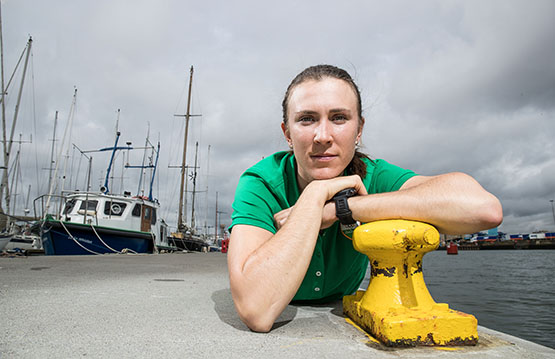 Annalise Murphy in thoughtful mood on Tuesday. Photo: Dan Sheridan/INPHO
Annalise Murphy in thoughtful mood on Tuesday. Photo: Dan Sheridan/INPHO
Inevitably the new-look Murphy has to be the most likely medal prospect, for despite her significant height, she’s certainly rated as a contender by her peers. Of the rest of the team, the two 49er guys have shown they can do it, they won the gold in Palma in April but have been erratic since, yet with the selected nature of the Olympic fleets, they could well be on the money.
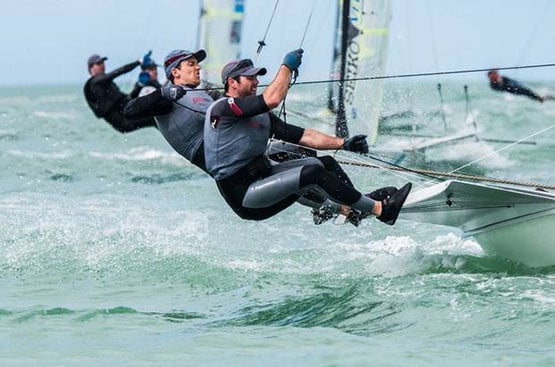 Ryan Seaton and Matt McGovern keeping busy
Ryan Seaton and Matt McGovern keeping busy
Andrea Brewster and Saskia Tidey on the women’s skiff made it into the Olympic qualification by the skin of their teeth, but if a sporting outlook and gallant determination are keys to success, then their showing will have an added interest.
While the rest of the team have been on the scene for a while, Finn Lynch is the new kid on the block. But despite only turning twenty back in April and then not getting his Olympic qualification until May, he has been maturing before our very eyes ever since he started this particular journey a year ago.
The Finn Lynch story just builds and builds, for not only is he the youngest member of the Irish sailing team by far, but he is competing in the most numerous class as the Lasers will be mustering 46 boats at Rio. And he will find himself racing in the distinguished company of one of the most popular sailors in the world, Brazil’s legendary Robert Scheidt, who at 43 will be the oldest competitor in the Sailing Olympics 2016.
There are great stories already there. And there could be some mighty stories in the making. As ISA Performance Director James O’Callaghan put it, it may be very much an outside shot, but we might even be due a medal. Either way, our dedicated Olympic squad – sailors and coaches alike – have brought sailing centre stage in the Irish consciousness for the next three weeks. But for now, they’re very deservedly in seclusion even if, in the outside world, the rumour mills will inevitably grind on.
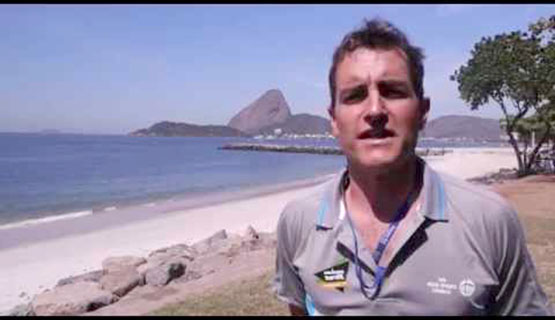 ISA Performance Director James O’Callaghan in Rio de Janeiro
ISA Performance Director James O’Callaghan in Rio de Janeiro
Irish Olympic Sailing Team Profiles for Rio
The chances of winning an Olympic sailing medal next month, have been described by Team manager James O'Callaghan as an 'outside shot'. Can Ireland's four boat Irish Olympic Sailing Team deliver on the 36–year medal drought? Afloat.ie gives its assessment boat by boat
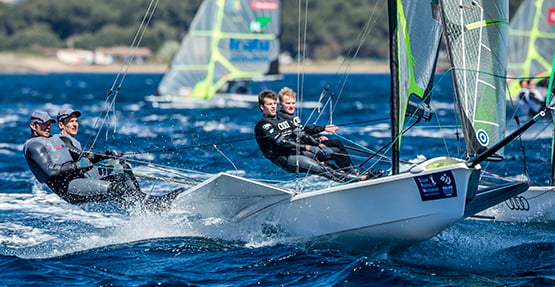 Belfast Lough's Ryan Seaton and Matt McGovern start racing in Rio on August 12
Belfast Lough's Ryan Seaton and Matt McGovern start racing in Rio on August 12
49er – Ryan Seaton & Matt McGovern
Ryan Seaton and Matthew McGovern have been steadily working their way up the world rankings this year, from 22ncd at the start of the year to 11th in the latest version. These London 2012 veterans (14th) have put in some stellar performances in recent months, most notably winning the Princesa Sofia Regatta in Palma in April.
Seaton and McGovern qualified Ireland at the first possible opportunity at the combined World Championships in Santander in 2014, finishing 8th. But their performance since has been erratic and the win in Palma was bookended by a 37th in Miami and a 28th at the 2016 Europeans. Most recently, at the international sailing week in Rio, the Belfast pair finished down the fleet, but may have been using this regatta for testing or training purposes.
There is no doubt, that on their day, Seaton and McGovern can compete with the world's best.
Men’s Skiff (49er) 20 competitors Race duration: 3 x 30 minutes daily (medal race 1 x 20 minutes) Competition days: Fri 12th/Sat 13th/Sun 14th (Reserve)/Mon 15th/Tue 16th/Wed 17th (Reserve)/Thu 18th - medal race/Fri 19th (Reserve)
 Dublin Bay's Andrea Brewster and Saskia Tidey start racing in Rio on August 12
Dublin Bay's Andrea Brewster and Saskia Tidey start racing in Rio on August 12
49erFx – Andrea Brewster & Saskia Tidey
Andrea Brewster and Saskia Tidey were the last of the Irish team to qualify, enduring heartbreak at the 2015 worlds where they were denied qualification by a protest in the final race report here. However, their performance at the Worlds was good enough to secure the next available place a few months later when no team from Africa emerged. Story here.
Brewster, a product of the British Olympic Laser radial squad, and Tidey, who transitioned from the Radial to the 49er following a season racing 18ft Skiffs in Sydney, have, until this year, hovered in the early 20s in world ranking and results at major events. 2016 has been something of a breakthrough for the Royal Irish duo, finishing in the teens more consistently, including a 12th at the European championships in Barcelona in April. A final day scoreline of 2,1,3 shows the potential that resides in this team.
Women’s Skiff (49erFX) 20 competitors Race duration: 3 x 30 minutes daily (medal race 1 x 20 minutes) Competition days: Fri 12th/Sat 13th/Sun 14th (Reserve)/Mon 15th/Tue 16th/Wed 17th (Reserve)/Thu 18th - medal race/Fri 19th (Reserve)
 Dublin Bay's Finn Lynch starts racing in Rio on August 8
Dublin Bay's Finn Lynch starts racing in Rio on August 8
Laser – Finn Lynch
Finn Lynch's fairytale journey to Rio is recounted in Sailing on Saturdays by Winkie Nixon. However he had to overcome the 2012 Olympian James Espey, who's 38th place at the 2014 world Championship in Santander qualified the country. ISA imposed a three regatta trials system, starting with the Copa de Brasil regatta in Rio in December 2015, where Espey shaded Lynch by one place. At the next event in Palma in March and April, neither sailor made gold fleet, but Espey increased his advantage with a 53rd to Lynch's 58th. Going into the final trial, the 2016 Laser Worlds in Mexico in May, Lynch had it all to do, but a solid series of consistent results saw him qualify for the Gold Fleet, while Espey never really got off the ground until it was too late.
While Lynch, who's best results have been at under age events, is certainly not a favourite for podium in Rio, his trajectory suggests that a medal in Tokyo in 2020 is well within his capability.
Men’s One-person dinghy (Laser) 46 competitors Race duration: 2 x 50 minutes daily (medal race 1 x 25 minutes) Competition days: Mon 8th/Tue 9th/Wed 10th/Thu 11th (Reserve day)/Fri 12th/Sat 13th/Sun 14th (Reserve)/Mon 15th - medal race/Tue 16th (Reserve)
 Dublin Bay's Annalise Murphy starts racing in Rio on August 8
Dublin Bay's Annalise Murphy starts racing in Rio on August 8
Laser Radial – Annalise Murphy
Currently perhaps Ireland's most famous sailor, Annalise Murphy dismissed the challenge of Aoife Hopkins in the three event trial. However, recent form contradicts her suggestion that she is one of eight in the fleet with the potential to win a medal in Rio. Since January, her results at major events have been 48th (Miami World Cup), 30th (Laser Europeans), 39th (Laser Worlds) and 34th (Weymouth World Cup). The historical profile of light and fickle winds at the Olympic venue suggests that Annalise, a heavy weather specialist, will struggle to make the medal race. The 2013 European champion has, however, surprised on many occasions before and as recently as this month scored an important win on Olympic waters in her last regatta before the Games at the Rio de Janeiro International Sailing Week. Results of that win are here.
Women’s One-person dinghy (Laser Radial) 37 competitors Race duration: 2 x 50 minutes daily (medal race 1 x 25 minutes) Competition days: Mon 8th/Tue 9th/Wed 10th/Thu 11th (Reserve day)/Fri 12th/Sat 13th/Sun 14th (Reserve)/Mon 15th - medal race/Tue 16th (Reserve)
Afloat.ie has charted the progress of the 2016 Olympic sailing team over the last four years in a dedicated Irish Olympic Sailing section
Olympic Sailing Team – Two Months to Improve Before Rio
After a weekend of poor Irish performances at the British round of the Sailing World Cup, the Irish Sailing Association has acknowledged results from Weymouth were 'far from ideal'.
The Sailing World Cup on the Dorset coast, billed as the 'final opportunity for sailors to lay down a marker before the Rio 2016 Olympic Games', was attended by 380 Olympic sailors from 44 nations.
Men’s skiff sailors Ryan Seaton and Matt McGovern from Belfast reached the medal race final which they led for its entirety before sailing the wrong course to the finish line.
London 2012 veteran Annalise Murphy, Ireland’s most successful sailing athlete in the last 30 years, had one of her most disappointing results of the season when she placed 34th in the 39–strong Laser Radial fleet. Murphy has been concentrating on preparations for her second appearance at the games but the Rio venue offers much lighter winds to four years ago when she narrowly missed a podium result.
Andrea Brewster and Saskia Tidey in the women’s skiff placed last in the 49erFX event.
“We have two months to focus on the things we can improve before starting the Olympic regatta in Rio', Team Manager James O'Callaghan said yesterday.
Men’s single-hander Finn Lynch, the youngest ever Irish helm to be selected for Team Ireland did not take part in the regatta due to training-camp commitments in Croatia.
The 49er pair have one further regatta at Kiel Week in Germany later this month before final preparations begin for their second Olympic appearance at Rio 2016 in August.
The first race in the Rio 2016 regatta begins on Monday 8th August when Murphy and Lynch begin their respective events.
A facebook campaign update from the 49er crew:
Course Error Costs Ireland 49er Medal Race Win in Weymouth
Producing a runaway lead following a second row start (scroll to timeline 2:46:00 on the video timeline below) in yesterday's Sailing World Cup medal race in Weymouth was a most impressive performance for Ireland's 49er pair Ryan Seaton and Matt McGovern until an unfortunate course error robbed the Belfast Lough sailors of a coveted Sailing World Cup medal race win.
After hitting the left hand corner to produce at times a 100–metre lead they showed some explosive boat speed and great boat handling but after two laps they mistook the finish line (scroll to timeline 3:08:00) and 'got stuck in the moment', according to helmsman Ryan Seaton.
Asked by media afterwards (scroll to timeline 3:14:00) who was responsible for navigation, crew Matt McGovern said: 'I think we all take a bit of responsibility; myself, Ryan and the coach'.
The Belfast pair recovered to finish seventh out of ten. It was a basic error they will want to forget but one better made now rather than in two months time in Rio.
Taking it in their stride and shrugging off the blunder, McGovern said he was not looking forward to the 'slagging' he was going to get when he got ashore.
Having raced so well, it was a big shame for Team Ireland not to have sealed the rare win but taking the whole race in context, Seaton and McGovern's performance was undeniably an impressive one and a great confidence boost for Rio.
'Results not what we had planned for but valuable time on the water nevertheless' is the ISA conclusion from a mixed bag of results posted by the Olympic Sailing Team in Weymouth this weekend. On the eve of the Rio Olympics, there is at least some consolation that Northern Ireland 49er pair Ryan Seaton and Matt McGovern are through to today's medal race final.
By virtue of winning the last race of four sailed yesterday, the Belfast Lough duo qualified for today's medal race. (Watch race live here at 13.50)
In the Laser Radial, the National Yacht Club's Annalise Murphy finished 34th, one behind Howth's Aoife Hopkins in the 39–boat class. Andrea Brewster and Saskia Tidey were 15 from 15 in the 49erfx womens skiff.
Although this 2016 edition of the Weymouth World Cup was a bit of a light air wash–out, expect competition to be a whole lot tougher in similar conditions in Rio in just 54 days time.
In a thrilling medal race final on the Bay of Palma today, Northern Ireland's Ryan Seaton and Matt McGovern won the Gold medal in the 49er skiff event at the Princess Sofia Regatta this afternoon. Seaton and McGovern started cleanly and led the fleet to the first mark but hit it forcing them to take a penalty turn that dropped them to ninth in a fleet of ten boats.
It was yet more drama after last night's giddy report that the pair had won Gold by a massive margin before protests had been heard. In a confusing scenario, Australia's Nathan Outteridge and Iain Jensen earned redress last night and although a podium for Ireland was still assured today only Gold would do for the Carrickfergus–Bangor partnership.
The skiff pair, who represented Ireland in the 49er at London 2012, worked their way steadily up the fleet to finish sixth, one place behind Outteridge and Jensen, more than sufficient to claim the Gold medal for Ireland. The best result of their 2016 campaign to date.
The result is a big endorsement of the progress the Ballyholme Yacht Club pairing have made, especially keeping 2012 Olympic Champions Outteridge and Jensen in second. Seaton summed it up: "To be so solid this week has been important. We have done a lot of work being able to go up and down the gears, a lot of the time sailing on our own. But we have done a lot of sailing. And we have re-established our training group we had before the last games with the Australians. So that has helped out in the lighter wind range. That is where our consistency has come. This was really a training regatta along the way, it's important but it is a great platform for us and the confidence it brings, winning a big regatta at this stage, is immense."
Seaton and McGoverns’ previous best results include Silver at the French Olympic classes regatta in Hyeres in 2014 and a Gold at the Weymouth pre-Olympic event in 2011. They placed 14th at the London 2012 Olympics.
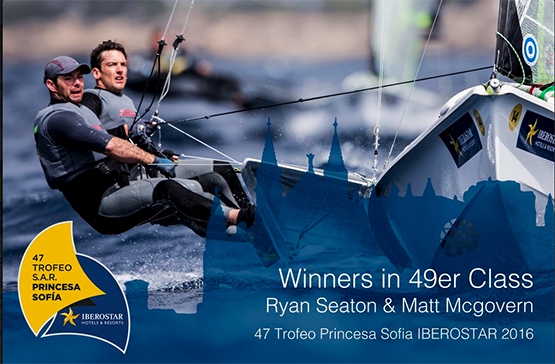
Already qualified for Rio in four month's time, the pair are members of the Providence Team Ireland ISA sailing squad as well as being RYA NI High Performance athletes. They are funded both by the Irish Sports Council and Sport NI’s Athlete Support Programme.
Y esto es lo que llaman felicidad...
— TrofeoPrincesaSofia (@TrofeoSofia) April 2, 2016
And this is what happiness means...
Congrats @RyanRyanseaton & @MatMcGovern :) pic.twitter.com/hW3bqRJ22q
Preceding, as it does, the 49er European Championships in just over one week in Barcelona and the Sailing World Cup in Hyeres coming up in April, Palma regatta is considered a vital 'training' rather than 'outcome' regatta. Let's hope the Irish 49er form continues
Selected results:
470 Men: 1.- Mathew Belcher/ Will Ryan (AUS): 21pts, 2.- Stu Macnay/Dave Hughes (USA): 49, 3.- Panagiotis Mantis/Pavlos Kagialis (GRE): 57.
470 W: 1.- Agnieszka Skrzypulec/Irmina Mrozek (POL): 48, 2.- Fernanda Oliveira/Ana Barbachan (BRA): 50, 3.- Amy Seabright/Anna Carpenter (GBR): 52
49er M: 1.- Ryan Seaton/Matt Mcgovern (IRL): 75pts, 2.- Nathan Outteridge/Iain Jensen (AUS ): 88 3.-Diego Botin/Iago López (ESP): 97:
49er FX: 1.-Annemiek Bekkering/Annette Duetz (NED): 61 2.- Jena Mai Hansen/Katja Steen (DEN): 74 3.-Tina Lutz/Susann Beucke (GER): 93
FINN: 1.- Josh Junior (NZL): 51pts, 2.- Giles Scott (GBR): 78, 3.- Tapio Nirkko (FIN): 78p
LASER STANDARD: 1.- Andrew Maloney (NZL): 57pts, 2.- Robert Scheidt (BRA): 66, 3.- Tonci Stipanovic (CRO): 72;
LASER RADIAL: 1.- Tuula Tenkanen (FIN):55, 2.- Evi Van Acker (BEL): 64, 3.- Anne-Marie Rindom (DEN): 65;
NACRA 17: 1.-Billy Besson/Marie Riou (FRA): 60pts, 2.- Thomas Zajac/Tanja Frank (AUT): 104, 3.- Allan Norregaard/Anette Viborg (DEN): 109pts
RS: X M: 1.- Tom Squires (GBR): 28pts , 2.- Pawel Tarnowski (POL): 40, 3.- Byron Kokkalanis (GRE): 41RS:X W: 1.- Olga Maslivets (RUS): 44pts 2.- Flavia Tartaglini (ITA): 51pts, 3.- Lilian De Geus (NED): 56.
2.4mR: 1.- Heiko Kröger (GER): 8, 2.- Damien Seguin (FRA): 15, 3.- Helena Lucas (GBR): 16pt
DRAGON: 1.-Lady Tati (POR): 8pts, 2.- Sun Flower (RUS): 14 3.-Convergens (RUS): 16
Update: Belfast Skiff Pair Ryan Seaton & Matt McGovern Racing For Gold at Princess Sofia Regatta
Update 8pm: Belfast pair Ryan Seaton and Matt McGovern now need any place in the top 8 (from 10 competitors) to secure gold tomorrow after an unassailable 27–point gap on their competitors today was cut–back when Australia secured redress in one of today's final rounds.
In an epic climax to a tough week afloat, the Northern Ireland leaders can make sure of gold tomorrow in the medal race finals. And in a further boost for Northern Ireland Olympic sailing, Royal Ulster's James Espey has extended his lead in the mens Laser in advance of the final Rio trial at the Laser world championships in May.
The 49er skiff class crew won the 15th and final race of the week to top the leaderboard in the 70-plus fleet.
The result so far is a major international success that eclipses their own silver medal achievement at the Sailing World Cup event in Hyeres in 2014 because it is only months before the Olympic regatta itself.
The medal race final in the 49er skiff class begins at 10.15am.
Seaton and McGovern have already qualified Ireland for the Rio 2016 Olympics and scored a top ten result at the recent world championships in Florida. Their next major event is the European Championships in May.
This is no flash-in-the-pan success. Seaton, who calls Carrickfergus home, and longtime sailing partner McGovern from Bangor on the other side of the lough, have been genuine contenders in this demanding class since the buildup to the 2012 Olympics, when they emerged in the front ranks. While they're well aware that sailing conditions in Brazil will be very different from the brisk weather which helped them this week, this result is a major shot in the arm for the ISA/RYA NI campaign.
In the Irish Laser class selection trial for the single Irish place at Rio 2016, London 2012 veteran James Espey emerged best of the three contenders when he placed 53rd overall in the Silver fleet. Finn Lynch was five places behind after the ten races and is just six points behind Espey in the trials.
Fionn Lyden had two top 20 results on the final day to finish in 68th place and demonstrated clear talent during the regatta to remain a threat to the leading sailors’ Rio 2016 ambitions. The third and final event in the selection trials will be the Laser World Championships in Mexico next month.
Meanwhile, Providence Team IRL's 49erFX women’s pair Andrea Brewster and Saskia Tidey finished the regatta with the best result of the week in 18th place overall.
Northern Ireland Sailors Have the Edge in Palma
Belfast's James Espey had an eighth and a tenth in the silver fleet of the Trofeo Princesa Sofia today to regain the lead in the Irish trial for the mens Laser berth in Rio. His main rival Finn Lynch suffered a 37th place in the morning race after a difficult first leg. He went on to place 14th this afternoon but not before the Royal Ulster sailor had edged ahead once more, this time with an 18-point lead.
Northern Ireland sailors also performed well in the 49er skiff, Ryan Seaton and Matt McGovern moved back up the standings in the 49er skiff class to hold joint first place overall.
Although the pair had a shaky start to the four-race day with a 15th place, they went on to deliver a 5-3-8 score. The Belfast lough pair have another four races to maintain their standing for what could be a well–earned podium on Saturday afternoon.
The moderate to fresh winds that were initially accompanied by a thick fog bank that delayed racing and saw another move in the snakes and ladders game for the Irish selection trials in the Laser class.
In the 49erFX skiff event, Providence Team IRL's Andrea Brewster and Saskia Tidey rounded off a difficult day with a solid fifth place, their best of a week that marks their return to competition after an injury enforced break.
Tomorrow (Friday) is the last day of racing in the finals round and the top ten boats in each of the 10 Olympic classes racing will qualify for the medal races on Saturday. As 49er class front-runners for most of the week, Seaton and McGovern will be the only Irish crew interest on Saturday.




























